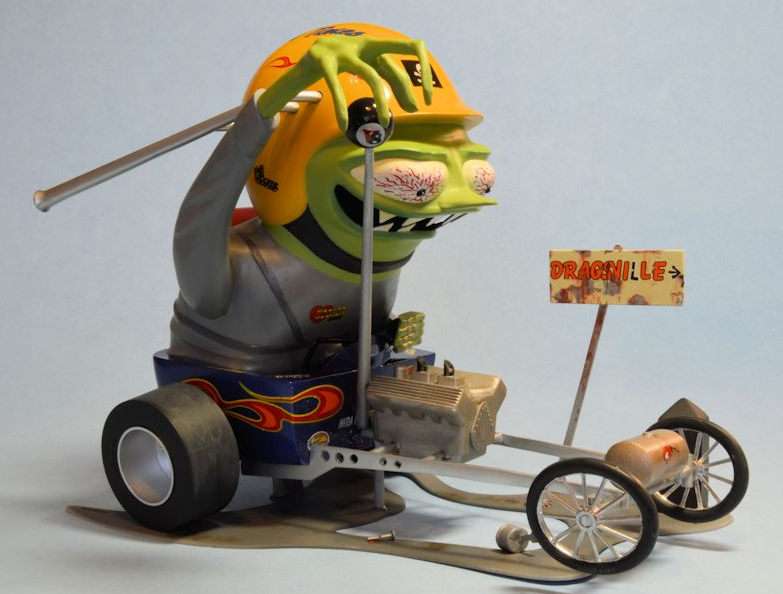
| KIT #: | 16001 |
| PRICE: | Around $10 'Used' |
| DECALS: | None |
| REVIEWER: | Otis Goodin |
| NOTES: | Fun model. Cheap, easy to assemble. Like being 9 years old again! |

| HISTORY |
While attending the annual Middle Tennessee IPMS show in Murfreesboro some months back I was wandering the vendor aisles looking at all the old kits for sale. One vendor had several old funky car models that made me think back to my days as a kid in the 60s building the Weird-Ohs series of models put out by Hawk. When I was about 9 years old (1964) my friends and I discovered some Weird-Ohs models at the local Morgan & Lindsay dime store in Greenville, Mississippi. We all bought one and quickly rode our bikes home and began building them. Of course we were all finished with them by nightfall and spent the next several days looking at them, playing with them, breaking them, etc. and figuring out ways to get more. We thought they were the coolest models around and we absolutely loved them. Of course as time passed the Weird-Ohs craze died down and we grew up and went on to other things. I really hadn’t thought about Weird-Ohs in decades when the thought suddenly came to me again looking at all those old models. Not able to find a Weird-Ohs model at the show I went to the next best thing, ebay, where I discovered that Weird-Ohs are still available and amazingly cheap so I bought the one reviewed here, “Digger” the Weird-Ohs dragster.
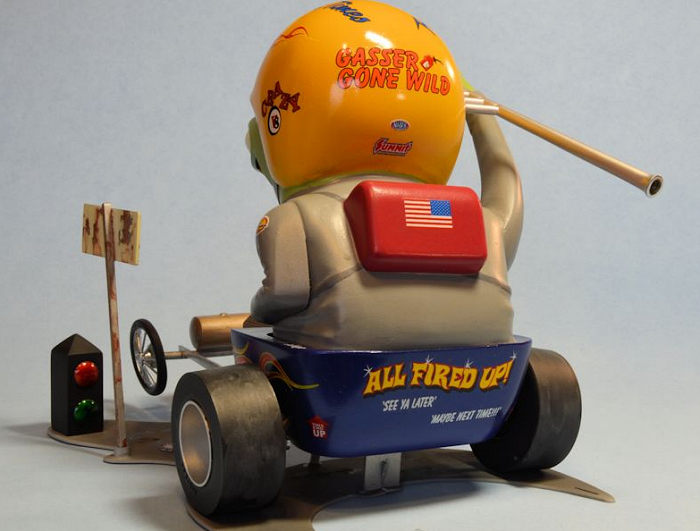 All this led me to do some
research into the history of Weird-Ohs and I discovered an article “History of
the Hawk ‘Weird-Ohs’ Plastic Model Kits” written in 2010 by Bill Campbell, the
original developer of the Weird-Ohs model line. As Bill tells the story he was
doing some contract work for Hawk, mainly producing box artwork. Around 1962
Bill was sure that most model builders of the day were tired of building another
car or plane kit so he set about coming up with something “way out.” In the
process he built some prototype models of some of his more developed thoughts.
Among them were the earliest Weird-Ohs “Digger”, “Davey” and “Daddy” along with
a few others. On one of his trips to Hawk he took his prototypes along and left
them with the two owners of Hawk for their thoughts. Later, Bill related, he
learned that at the time the two owners, Dick and Phil Mates, were not that
crazy about them and left them in the conference room while they thought about
it. However, later that week Hawk was hosting a group of their distributors who
stumbled on to the prototypes in the conference room. The distributors were much
more enthusiastic about the concept so the idea of the crazy looking models
persisted for a while longer. Following this, Bill got a call from the Hawk
marketing director to discuss the possibility of producing a run of the kits in
time for the upcoming hobby show in Chicago to gauge reaction to the concept.
They needed a name for the kits and Bill stated that “they are just a bunch of
Weird-Ohs” so it was agreed that would be the name.
All this led me to do some
research into the history of Weird-Ohs and I discovered an article “History of
the Hawk ‘Weird-Ohs’ Plastic Model Kits” written in 2010 by Bill Campbell, the
original developer of the Weird-Ohs model line. As Bill tells the story he was
doing some contract work for Hawk, mainly producing box artwork. Around 1962
Bill was sure that most model builders of the day were tired of building another
car or plane kit so he set about coming up with something “way out.” In the
process he built some prototype models of some of his more developed thoughts.
Among them were the earliest Weird-Ohs “Digger”, “Davey” and “Daddy” along with
a few others. On one of his trips to Hawk he took his prototypes along and left
them with the two owners of Hawk for their thoughts. Later, Bill related, he
learned that at the time the two owners, Dick and Phil Mates, were not that
crazy about them and left them in the conference room while they thought about
it. However, later that week Hawk was hosting a group of their distributors who
stumbled on to the prototypes in the conference room. The distributors were much
more enthusiastic about the concept so the idea of the crazy looking models
persisted for a while longer. Following this, Bill got a call from the Hawk
marketing director to discuss the possibility of producing a run of the kits in
time for the upcoming hobby show in Chicago to gauge reaction to the concept.
They needed a name for the kits and Bill stated that “they are just a bunch of
Weird-Ohs” so it was agreed that would be the name.
Bill and the marketing director, John Andrews, decided on a plan of action to get enough models produced in time for the upcoming hobby show. Bill would work on the box art and John would start creating the dies for the actual models. As they worked on their separate tasks, Bill more fully developed his concept for the kits while John went right to creating the molds based on the original prototypes…without consulting with Bill. As a result, the box art was a somewhat different product from the actual models. Being short of time, the Mates brothers decided to go with what they had and hope for the best.
Hawk took box art and six
models to the 1963 Chicago Hobby Convention. At first people didn’t know how to
take them but after a little while they became the talk of the show. Hawk
salespeople began writing up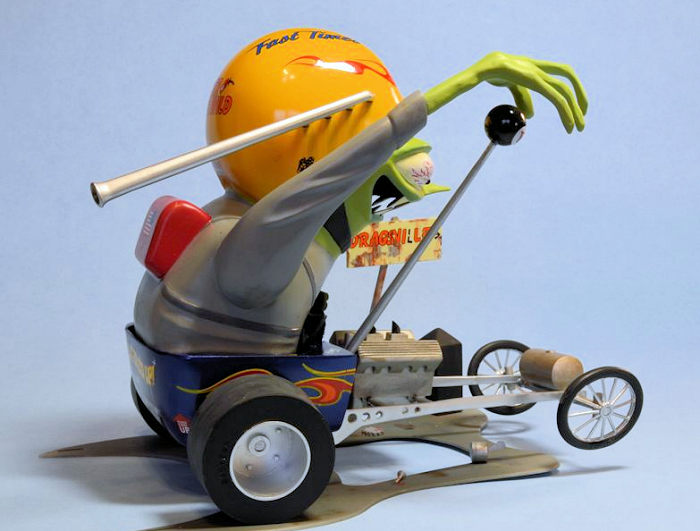 orders for the models and before they knew it they
had thousands of orders which shortly turned into hundreds of thousands. The
Hawk factory went into overtime and could not keep up with the demand for the
kits. Following this Bill and the Hawk Company set about expanding the Weird-Ohs
line of models, adding several more to the original six. As the popularity grew
Weird-Ohs were expanded into trading cards, decals, records, Milton Bradley
games and puzzles. The Weird-Ohs craze lasted longer than anyone dreamed and
Hawk made a good return on their investment. Eventually Weird-Ohs ran its course
and the Hawk company was later sold to Testors who inherited all the Weird-Ohs
stuff. In the early 90s Testors re-released the Weird-Ohs, but instead of the
original box art they put a photo of the model on the box. Let’s just say the
photo didn’t generate the enthusiasm for the kits that the box art did and
Testors eventually went back to using the old box art.
orders for the models and before they knew it they
had thousands of orders which shortly turned into hundreds of thousands. The
Hawk factory went into overtime and could not keep up with the demand for the
kits. Following this Bill and the Hawk Company set about expanding the Weird-Ohs
line of models, adding several more to the original six. As the popularity grew
Weird-Ohs were expanded into trading cards, decals, records, Milton Bradley
games and puzzles. The Weird-Ohs craze lasted longer than anyone dreamed and
Hawk made a good return on their investment. Eventually Weird-Ohs ran its course
and the Hawk company was later sold to Testors who inherited all the Weird-Ohs
stuff. In the early 90s Testors re-released the Weird-Ohs, but instead of the
original box art they put a photo of the model on the box. Let’s just say the
photo didn’t generate the enthusiasm for the kits that the box art did and
Testors eventually went back to using the old box art.
Today you can find Weird-Ohs on ebay at about $10 a kit, with a pretty good supply available.
| THE KIT |
The kit consists of about 35 parts made of medium gray plastic. The instructions are very basic and are contained on the front and back of a single sheet of paper. There are no painting instructions or decals with the kit. In fact the box states “Paint ‘em Your Own Weird Way” so it’s a pretty open ended choice. I don’t remember if the original Weird-Ohs had decals or not. This was also in the day before photo-etch. The actual model character “Digger” is much larger in proportion to the vehicle than the box art suggests.
| CONSTRUCTION |
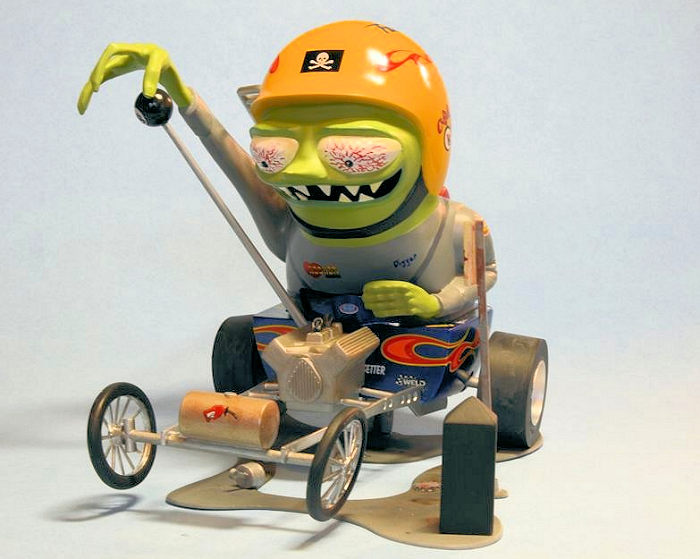 Construction begins with
assembly of Digger himself, which consists of six parts: right half, left
half, face, two arms and one hand. I cleaned up the parts which required
some sanding and filling of a few divots including a rather large one in the
palm of the right hand. Once assembled, a fair amount of puttying was
required to fill the gaps. In fact it took two or three attempts depending
on the location to get all the gaps filled. I also hollowed out the end of
the exhaust pipe and attached it to the helmet. Once Digger was finished I
put him aside and went to work on the other parts.
Construction begins with
assembly of Digger himself, which consists of six parts: right half, left
half, face, two arms and one hand. I cleaned up the parts which required
some sanding and filling of a few divots including a rather large one in the
palm of the right hand. Once assembled, a fair amount of puttying was
required to fill the gaps. In fact it took two or three attempts depending
on the location to get all the gaps filled. I also hollowed out the end of
the exhaust pipe and attached it to the helmet. Once Digger was finished I
put him aside and went to work on the other parts.
Next up was the “body” of the dragster which was a single piece, however I decided to upgrade it a bit because Digger (his top half actually) just sat precariously on a couple of small bits of plastic, and his missing bottom half was clearly visible (or not visible!). To remedy this I created a small deck to sit on top of the dragster body and provide some cover for Digger’s missing bottom half. I used Evergreen sheet styrene for this, and also built up the small bits of plastic on the inside of the body so Digger would have something more substantial to sit on. Following this I created a “dashboard” of sorts to provide some cover for the steering wheel which doesn’t connect to anything! I added a small piece of round Evergreen styrene to the steering wheel to represent a steering column and attached the wheel to the dragster body behind the dashboard. I puttied and sanded the additions and put the car body aside while I turned my attention to the rails.
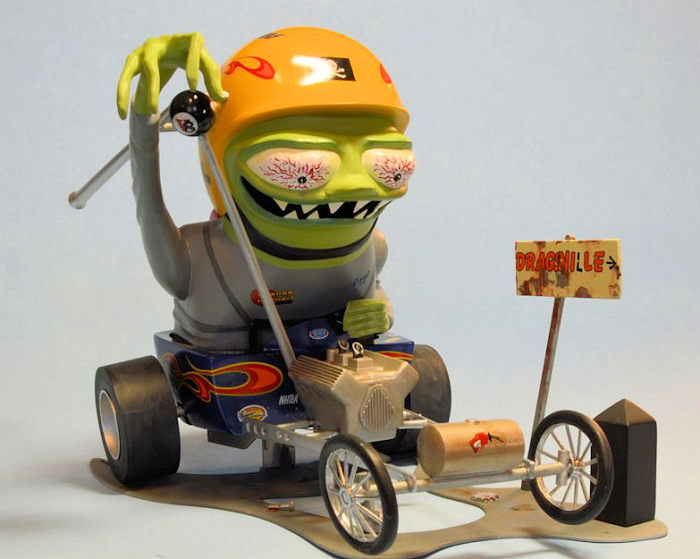 Looking at pictures of other
completed “Diggers” it was obvious that the rails were too short compared to
actual dragsters so I decided to lengthen mine a bit. To do so I simply cut the
rails in two just past the engine mounts and added about 1 ¼ inch of sheet
styrene to each rail to make it longer. I glued, puttied and sanded the added
lengths to blend it in and then painted the rails. In retrospect I wish I had
made them even longer, but once done with the modification I had no desire to do
it over. It still looks better than the original.
Looking at pictures of other
completed “Diggers” it was obvious that the rails were too short compared to
actual dragsters so I decided to lengthen mine a bit. To do so I simply cut the
rails in two just past the engine mounts and added about 1 ¼ inch of sheet
styrene to each rail to make it longer. I glued, puttied and sanded the added
lengths to blend it in and then painted the rails. In retrospect I wish I had
made them even longer, but once done with the modification I had no desire to do
it over. It still looks better than the original.
Following this I assembled other small parts including the wheels, stick shift, gasoline tank, road sign and the base, puttied and sanded as needed and began painting. A piece of copper wire was added to represent a fuel line from the gasoline tank to the engine. I also scattered a few loose engine parts on the base.
| COLORS & MARKINGS |
As stated
earlier there are no painting instructions or decals included with the kit so
it’s modeler’s choice on all options. I decided to stick pretty close to the box
art so Digger’s face and hands were painted Model Master Pale Green modified
with a bit of RLM Yellow and White to give it a more “ghoulish” color. The lips
and eyebrows were highlighted with some pure Pale Green. His eyes are painted MM
White and Aged White around the edges, eyeballs are black with a spot of white
to represent “sparkle”, and the bloodshot effect, standard on all Weird-Ohs, was
rendered with a Staedler Permanent Marker Extra Fine Point. (I didn’t trust
myself to paint them). His teeth are painted with a combination of White,
highlighted (or lowlighted) with some Aged White. His uniform is painted a MM
Neutral Gray with his backpa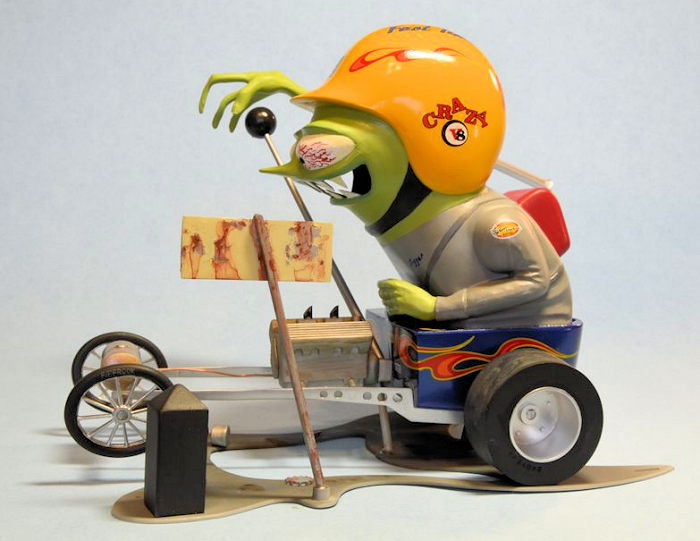 ck painted Gunze Wine Red. I hand wrote “Digger” on
his uniform using a permanent marker. Digger’s helmet is painted MM Chrome
Yellow over a base coat of a bright Gunze Orange Yellow, and given a high gloss
with Future. The exhaust pipe on Digger’s helmet was painted Chrome Silver. The
end was weathered with a little Jet Exhaust.
ck painted Gunze Wine Red. I hand wrote “Digger” on
his uniform using a permanent marker. Digger’s helmet is painted MM Chrome
Yellow over a base coat of a bright Gunze Orange Yellow, and given a high gloss
with Future. The exhaust pipe on Digger’s helmet was painted Chrome Silver. The
end was weathered with a little Jet Exhaust.
The car body was painted a dark MM Metallic Arctic Blue to provide a good background for the decals. The engine was painted MM Steel with a few Gun Metal notes here and there, then weathered with a wash of Black and Burnt Umber oil paints. The rails were painted Chrome Silver as were the wheel hubs and spokes. The tires were painted MM Flat Black lightened a little with White to make the tires a bit grayer. They were also weathered with a wash of thinned light gray. The gasoline tank was painted Polly Scale Copper (which looks like brass), with the cap painted silver.
The base was painted a Neutral Gray color, randomly oversprayed with Schwarzgrau, then a few oil stains added with a mix of Griffin’s Black and Burnt Umber. The scattered engine parts were painted Steel and a bit of Rust. The sign was painted MM Steel, randomly masked in a few places with Winsor & Newton masking fluid then overpainted with Aged White. When dry the masking fluid was removed leaving a sign that is losing its paint job. Following this I used decals for the Dragsville lettering because I didn’t trust myself to hand paint the letters. The letters were separately cut from the decal sheet and rearranged to spell Dragsville. I then applied MM Rust in places to complete the weathering of the sign.
I saw the dragster theme as an opportunity to add lots of decals both to the car and driver. I ordered a couple of 1/25 scale racing decal sets from ebay and went about applying a good variety of decals to the car body, gasoline tank, Digger’s helmet, back pack and uniform. I used dragster and hot rod themed decals for effect.
| CONCLUSIONS |
All the completed parts went together with no problem. The dragster’s front end leaves the ground by virtue of a small support piece mounted into the base underneath the stick shift.
I enjoyed building “Digger” again, but I know I spent a lot more time and effort on him than I did fifty plus years ago. Hopefully the results prove it! He is now a proud addition to my grandson’s playroom.
| REFERENCES |
Various internet photos of Weird Ohs models, and dragsters.
“History of the Hawk ‘Weird-Ohs’ Plastic Model Kits,” Bill Campbell, edited by Alan Bussie, oldmodelkits.com.
14 February 2017
Copyright ModelingMadness.com
If you would like your product reviewed fairly and fairly quickly, please contact the editor or see other details in the Note to Contributors.
Back to the Main Page Back to the Review Index Page Back to the Previews Index Page